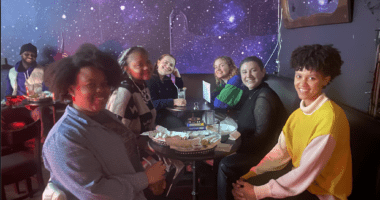This year, Community-Word Project’s Teaching Artist Training & Internship Program (TATIP) partnered with Sarah Lawrence College’s Child Development Institute to put on the 6th annual Summer Institute program.

On Wednesday, July 20th, 22 Advanced Teaching Artists traveled north of the city to Sarah Lawrence for the first day of Summer Institute 6.0. For a number of years, the focus of the institute has been centered around teaching for social justice and this year was no exception. From the first hour of the institute, facilitators Patti Chilsen and Renée Watson had the participants questioning what it means to teach through activism and art. They asked about current events, challenges and what compelled them to teach social justice, prompting the participants to respond on “graffiti walls” so that they could compare their reactions to their peers.

The group got to know each other more intimately through a game (a CWP favorite) called Mingle Mingle, in which participants ask each other questions about their art and activism like, “What activists do you admire or inspires you?” or “When did you know you were a teacher?”.

These activites set the groundwork for the day and created a platform of mutual respect and inquiry, allowing for a more indepth look at what it means to be Teaching Artists in the world today.
The institute uses, in addition to other philosophies, The Six Elements of Social Justice by Bree Picower as a foundation for its pedagogy and as a lens through which we analyze and create impactful curriculums. After studying and reflecting on these elements as a group, we were ready to test out their possibilites through a lesson that focused on writing and visual art by creating political cartoons.

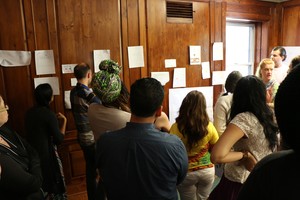

One participant quoted Cornel West as her respresentation of social justice in our discussion.

Day 1 focused on creating a strong foundation for teaching social justice, which informed the growth and movement for Day 2. The second day looked into what causes us to see single stories, privilege and our own creative elements. We started out by looking at a TedTalk by Novelist Chimamanda Ngozi Adichie on the dangers of a single story. In the video, Adichie tells the story of how she found her authentic cultural voice — and warns that if we hear only a single story about another person or country, we risk a critical misunderstanding. After the video, we took a hard look at the ways in which we’ve (accidently or not) created single stories in our classrooms and how we can fix that in the future through a number of ways, such as creating a diverse library and using multiple lessons to look at varying aspects of a culture or people.

We looked at diverse children’s picture books like “Hairs” by Sandra Cisneros, but took them one step further by bringing them to life through various forms of theatre: Greek chorus, puppetry, etc.

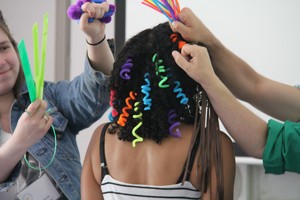
We took a hard look a privilege – who has it, who holds the power – by modeling the idea of it through an activity.
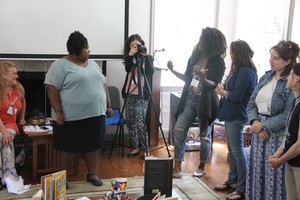
Participants were able to feel the injustice behind privilege and focus on how that can be explored in a classroom.

The day ended with the creation of artist maps, in which the participants explored what informs their own artistry and how they can use these creative elements to not only facilitate artmaking in their classrooms, but how they can use their own backgrounds to highlight teaching for social justice.





If Days 1 & 2 were the exploration of artistry and learning, then Day 3 certainly highlighted the activism part of teaching for social justice.

For Day 3, we traveled into the heart of Harlem in order to take our work to the streets. The Arts Horizons LeRoy Neiman Arts Center hosted us and we were more than grateful to hold our final day at this beautiful museum whose mission “is to strengthen the community through the arts by providing quality arts experiences that encourage lifelong learning for students of all ages, supporting the skills for life-long learning and building sustainable partnerships and collaboration”.

We used the museum’s current exhibit to reflect and respond to, letting it inform an opening warm up.

We discussed a Legacy of Leadership and asked the participants how these pieces spoke to one another, how they broadened the single story we’ve heard?
The final morning focused on poetry and activism, asking the participants to create something based off images from current events, specifically events surrounding the Black Lives Matter movement. The images were a mix of protesters, rallies, and photographs of those who were shot by police officers, including Trayvon Martin, Sandra Bland, Alton Sterling, Freddie Gray, and too many others.

Building upon our indivdual pieces, the room was broken into smaller groups and the facilitators asked the participants to find ways to combine their poems into a collaborative community poem.

From there, the groups created performance pieces. They found ways to use all art forms in these collaborative pieces, and then took them outside to the streets of Harlem in order to share with the community and take action.
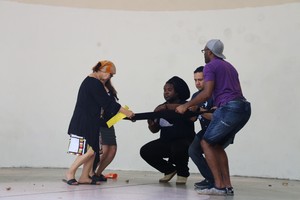


They used chalk, drums, music, vocals, dance, visual art and more in order to attract the attention of the community. Many, many people stopped out of curiosity and the groups were happy to explain the project. Each group performed in a different part of the neighborhood, including The Jackie Robinson Bandshell and in front of the police department.


Encouraged by the participants to ask questions of society and inspired by their activism, one small boy asked to write something and we were all moved by his response:

The day was challenging, but the outcomes moving and sparked interest in the community, motivating people to ask questions and speak up about the injustices happening today.

We ended the day with reflection and discussion, talking about highlights of all three days, our group projects and how we can move forward.
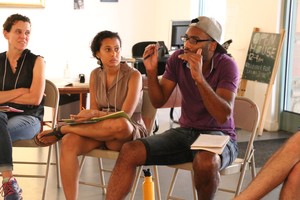

We stopped by a local restaurant, Peque Vinos + Tapas, for a little celebration and community sharing after the day’s work was done!



It was a successful Summer Institute. We were honored to work with brilliant and inspiring artists and activists.
Interested in Teaching Artist training? Find out more about what we do and our 2016-17 TATIP training here!



